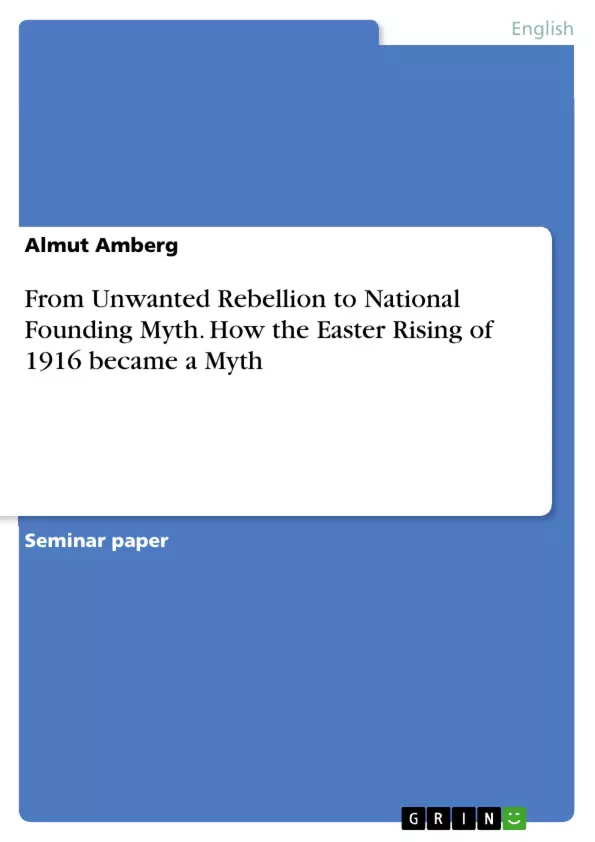When reading articles about the 100th anniversary of the Easter Rising in Dublin, one encounters the word ‘myth’ sooner or later. Repeatedly, it is mentioned how mythicized Ireland’s past is. How is this possible? How is it acceptable to call a historical event that happened only one hundred years ago a myth? Is its existence in question? Why is it treated like a legend?
The Easter Rising of 1916 was a rebellion planned in secret by the military council of the Irish Volunteers and the Irish Citizen Army. The rebels seized Dublin’s city centre, declared an Irish Republic and managed to defend their position for nearly one week until they ultimately surrendered to the forces of the British army which were superior in number. The rebels’ names – Pádraic Pearse, Tom Clarke, Séan MacDiarmada, Joseph Plunkett among others – became the names of Irish national heroes though in the initial reaction of the Irish public this did not seem likely. When the rebel leaders were escorted into captivity, the public loathed them – for the destruction of the city, the unnecessary rebellion during the Great War and the threat they posed to Home Rule.
However, the rebels and revolutionaries cursed by their contemporaries became national heroes over time. The unwelcome rebellion today is considered a foundational event or a national myth of the Irish Republic. How did this change come to pass? How does an event become a myth during the lifespan of those who lived through it? Why does this version of the narrative seem to be the commonly accepted one?
Inhaltsverzeichnis (Table of Contents)
- Introduction
- Theory of Myth
- Definition
- Functions and Characteristics of Myth
- The Easter Rising as a Myth
- Mythmaking by Pádraic Pearse
- Staging of the Rising
- The Myth of Blood-Sacrifice
- Conclusion
- Sources
Zielsetzung und Themenschwerpunkte (Objectives and Key Themes)
This essay aims to investigate the transformation of the Easter Rising of 1916 from an initially unwelcome rebellion into a foundational event and national myth of the Irish Republic. It examines how an event can be mythologized during the lifespan of those who experienced it, exploring the factors contributing to the acceptance of this narrative.
- The role of myth in shaping and controlling communities
- The influence of charismatic figures like Pádraic Pearse in mythmaking
- The importance of narrative and emplotment in constructing and disseminating myths
- The process of mythification as a dynamic and ongoing process of meaning-making
- The impact of myths on shaping historical perception and influencing present-day realities
Zusammenfassung der Kapitel (Chapter Summaries)
- Introduction: The essay introduces the concept of the Easter Rising as a myth, questioning how a relatively recent historical event can be considered mythical and its significance in Irish national identity.
- Theory of Myth: This chapter explores the definition of myth in a cultural studies context, distinguishing it from traditional definitions and emphasizing its role as a powerful narrative that shapes community values and perceptions.
- The Easter Rising as a Myth: This section delves into the mythmaking process surrounding the Easter Rising, focusing on the influence of Pádraic Pearse, the staging of the rebellion, and the myth of blood sacrifice as crucial factors in shaping the event's narrative.
Schlüsselwörter (Keywords)
The main keywords and focus topics of this text include: Easter Rising, Irish myth, national identity, historical narrative, mythmaking, emplotment, blood sacrifice, Pádraic Pearse, narrative control, community values, historical perception.
- Quote paper
- Almut Amberg (Author), 2016, From Unwanted Rebellion to National Founding Myth. How the Easter Rising of 1916 became a Myth, Munich, GRIN Verlag, https://www.grin.com/document/954651



